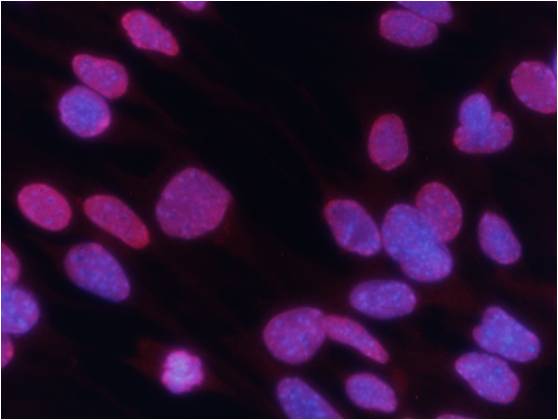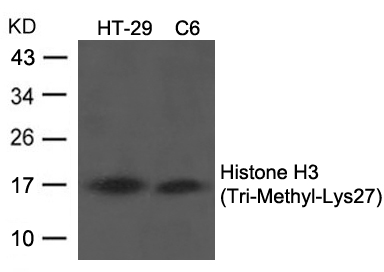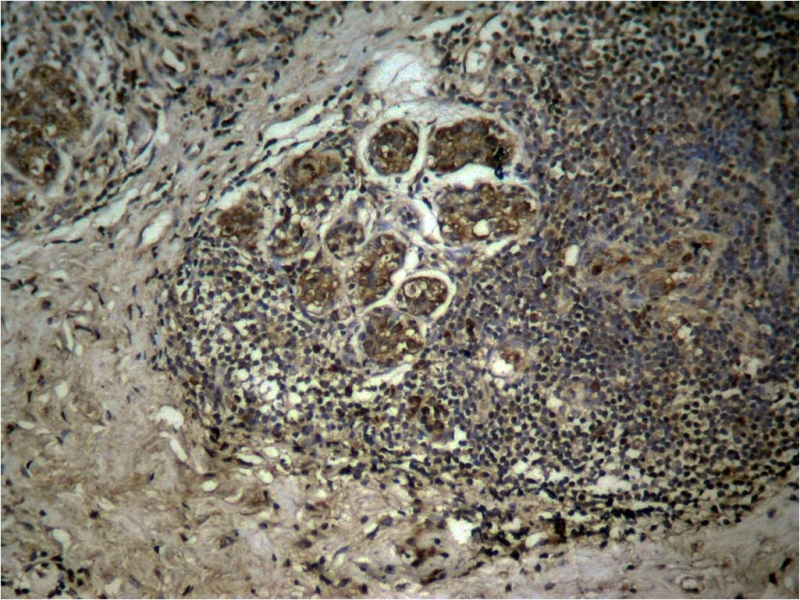


| WB | 咨询技术 | Human,Mouse,Rat |
| IF | 咨询技术 | Human,Mouse,Rat |
| IHC | 1/50-1/100 | Human,Mouse,Rat |
| ICC | 1/100-1/200 | Human,Mouse,Rat |
| FCM | 咨询技术 | Human,Mouse,Rat |
| Elisa | 咨询技术 | Human,Mouse,Rat |
| Aliases | H3/a, H3/c, H3/d, H3/f, H3/h |
| Entrez GeneID | 8350;8351;8352;8353;8354;8355;8356;8357;8358;8968; |
| WB Predicted band size | 17kDa |
| Host/Isotype | Rabbit IgG |
| Antibody Type | Primary antibody |
| Storage | Store at 4°C short term. Aliquot and store at -20°C long term. Avoid freeze/thaw cycles. |
| Species Reactivity | Human,Mouse,Rat |
| Immunogen | Peptide sequence around Tri-Methylation site of lysine 27(A-R-K(tri-methyl)-S-A) derived from Human Histone H3. |
| Formulation | Purified antibody in PBS with 0.05% sodium azide. |
+ +
以下是关于Histone H3 (Tri-Methyl-Lys27)(H3K27me3)抗体的3篇经典参考文献:
---
1. **文献名称**:Role of histone H3 lysine 27 methylation in Polycomb-group silencing
**作者**:Cao, R. et al.
**摘要**:该研究首次鉴定了H3K27的三甲基化(H3K27me3)是Polycomb抑制复合体PRC2介导的基因沉默的关键表观遗传标记,并揭示了其在发育调控中的作用。
---
2. **文献名称**:Drosophila enhancer of Zeste/ESC complexes have a histone H3 methyltransferase activity that marks chromosomal Polycomb sites
**作者**:Czermin, B. et al.
**摘要**:研究通过使用H3K27me3特异性抗体,证明果蝇PRC2复合体具有甲基转移酶活性,能够催化H3K27的三甲基化,从而调控染色质结构和基因表达。
---
3. **文献名称**:Polycomb complexes repress developmental regulators in murine embryonic stem cells
**作者**:Boyer, L.A. et al.
**摘要**:通过H3K27me3抗体的ChIP-seq分析,揭示了该修饰在小鼠胚胎干细胞中特异性富集于发育相关基因的启动子区域,维持其抑制状态以保障多能性。
---
4. **文献名称**:Genome-wide maps of chromatin state in pluripotent and lineage-committed cells
**作者**:Mikkelsen, T.S. et al.
**摘要**:利用H3K27me3抗体绘制了多能细胞和分化细胞的组蛋白修饰全基因组图谱,发现H3K27me3与基因沉默区域及细胞命运决定密切相关。
---
这些研究均通过H3K27me3抗体的应用,推动了Polycomb介导的表观遗传调控机制的理解。
**Background of Histone H3 (Tri-Methyl-Lys27) Antibody**
Histone H3 tri-methylated at lysine 27 (H3K27me3) is a post-translational modification (PTM) associated with transcriptional repression and epigenetic regulation. This mark is catalyzed by Polycomb Repressive Complex 2 (PRC2), primarily through its catalytic subunit EZH2. H3K27me3 plays a critical role in maintaining cell identity by silencing lineage-specific genes during development and differentiation. It is enriched at promoter regions of target genes, facilitating chromatin compaction and preventing access to transcription machinery.
Dysregulation of H3K27me3 is linked to various diseases, including cancers. Overexpression of EZH2 or aberrant H3K27me3 levels are observed in malignancies such as lymphoma, breast cancer, and glioblastoma, often correlating with poor prognosis. Conversely, loss of H3K27me3 due to mutations in PRC2 components can drive developmental disorders and tumorigenesis.
Antibodies targeting H3K27me3 are essential tools for studying these mechanisms. They enable detection of this epigenetic mark via techniques like chromatin immunoprecipitation (ChIP-seq), immunofluorescence, and Western blotting. Specificity and validation are critical, as cross-reactivity with other methylated lysine residues (e.g., H3K27me1/me2) must be ruled out. These antibodies are widely used in cancer research, stem cell biology, and developmental studies to explore gene silencing dynamics, PRC2 activity, and therapeutic targeting of epigenetic pathways.
In summary, H3K27me3 antibodies are pivotal for unraveling the role of Polycomb-mediated gene repression in health and disease.
×